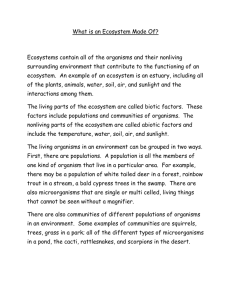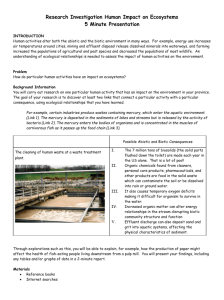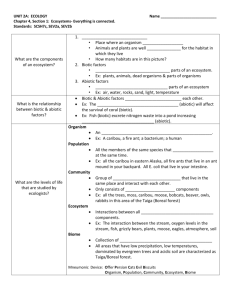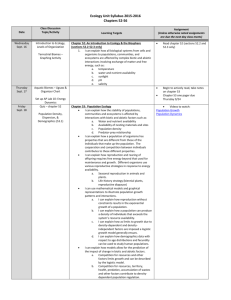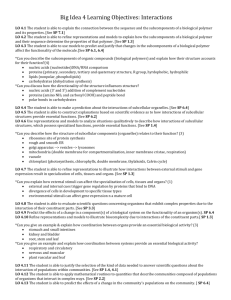The ESSENTIAL KNOWLEDGE for Ecology
advertisement
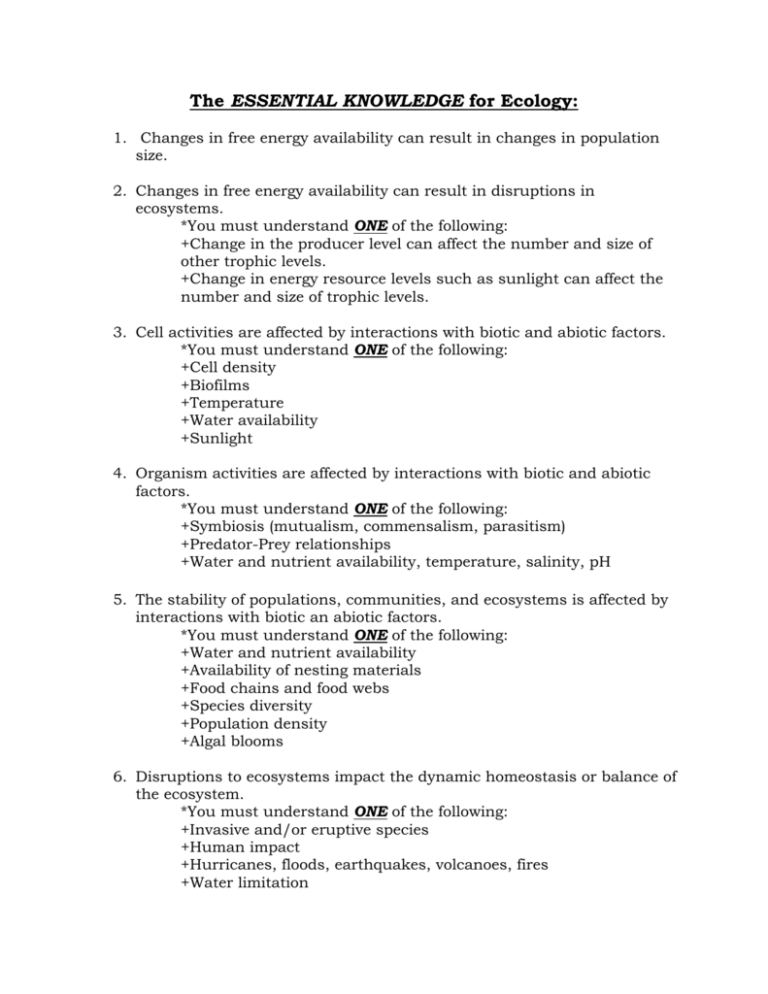
The ESSENTIAL KNOWLEDGE for Ecology: 1. Changes in free energy availability can result in changes in population size. 2. Changes in free energy availability can result in disruptions in ecosystems. *You must understand ONE of the following: +Change in the producer level can affect the number and size of other trophic levels. +Change in energy resource levels such as sunlight can affect the number and size of trophic levels. 3. Cell activities are affected by interactions with biotic and abiotic factors. *You must understand ONE of the following: +Cell density +Biofilms +Temperature +Water availability +Sunlight 4. Organism activities are affected by interactions with biotic and abiotic factors. *You must understand ONE of the following: +Symbiosis (mutualism, commensalism, parasitism) +Predator-Prey relationships +Water and nutrient availability, temperature, salinity, pH 5. The stability of populations, communities, and ecosystems is affected by interactions with biotic an abiotic factors. *You must understand ONE of the following: +Water and nutrient availability +Availability of nesting materials +Food chains and food webs +Species diversity +Population density +Algal blooms 6. Disruptions to ecosystems impact the dynamic homeostasis or balance of the ecosystem. *You must understand ONE of the following: +Invasive and/or eruptive species +Human impact +Hurricanes, floods, earthquakes, volcanoes, fires +Water limitation +Salinity 7. Individuals can act on information and communicate it to others. *You must understand EACH of the following: +Innate behaviors are behaviors that are inherited. +Learning occurs through interactions with the environment and other organism. 8. Responses to information and communication of information are vital to natural selection. *You must understand EACH of the following: +In phototropism in plants, changes in the light source lead to differential growth, resulting in maximum exposure of leaved to light for photosynthesis. +In Photoperiodism in plants, changes in the length of night regulate flowering and preparation for winter. +Behaviors in animals are triggered by environmental cues and are vital to reproduction, natural selection and survival. *You must understand ONE of the following: +Hibernation +Estivation +Migration +Courtship +Cooperative behavior within or between populations contributes to the survival of the populations. *You must understand ONE of the following: +Availability of resources leading to fruiting body formation in fungi and certain types of bacteria. +Niche and resource partitioning +Mutualistic relationships (lichens bacteria in digestive tracts of animals, mycorrhizae) +Biology of pollination 9. Organisms exchange information with each other in responses to internal changes and external cues, which can change behavior. *You must understand ONE of the following: +Fight or flight response +Predator warnings +Protection of young +Plant-plant interactions due to herbivory +Avoidance responses 10. Communication occurs through various mechanisms. *You must understand EACH of the following: +Living systems have a variety of signal behaviors or cues that produce changes in the behavior of the organisms and can result in differential reproductive success. *You must understand EACH of the following: +Herbivory responses +Territorial marking in mammals +Coloration in flowers +Animals use visual, audible, tactical, electrical and chemical signals to indicate dominance, find food, establish territory and insure reproductive success. *You must understand ONE of the following: +Bee dances +Bird songs +Territorial markings in mammals +Pack behavior in animals +Herd, flock, and schooling behavior in animals +Predator warning +Colony and swarming behavior in insects +Coloration 11. Cooperative behavior tends to increase the fitness of the individual and the survival of the population. *You must understand ONE of the following: +Pack behavior in animals + Herd, flock, and schooling behavior in animals +Predator warning +Colony and swarming behavior in insects 12. The structure of community is measured and described in terms of species composition and species diversity. 13. Mathematical or computer models are used to illustrate and investigate population interactions within and environmental impacts on a community. *You must understand ONE of the following: +Predator/prey relationships spreadsheet model +Symbiotic relationship +Graphical representation of field data +Introduction of species +Global climate change models 14. Mathematical models and graphical representations are used to illustrate population growth patterns and interactions. *You must understand EACH of the following: +Reproduction without constraints results in the exponential growth of a population. +A population can produces a density of individuals that exceed the system’s resource availability. +As limits to growth due to density-dependent and densityindependent factors are imposed, a logistic growth model generally ensues. +Demographics data with respect to safe distributions and fecundity can be used to study human populations. 15. Energy flows but matter is recycled. 16. Changes in regional and global climates and in atmospheric composition influence patterns of primary productivity. 17. Organisms within food webs and food chains interact. 18. Food chains and food webs are dependent on primary productivity. 19. Models allow the prediction of the impact of change in biotic and abiotic factors. *You must understand EACH of the following: +Competition for resources and other factors limits growth and can be described by the logistic model. +Competition for resources, territoriality, health, predation, accumulation of wastes and other factors contribute to densitydependent population regulation. 20. Human activities impact ecosystems on local, regional and global scales. *You must understand EACH of the following: +As human populations have increased in numbers, their impact on habitats for other species have been magnified. +In turn, this has often reduced the population size of the affected species and resulted in habitat destruction and, in some cases, the extinction of species. 21. Many adaptations of organism are related to obtaining and using energy and matter in a particular environment. 22. Interactions among cells of a population of unicellular organism can be similar to those of multicellular organisms, and these interactions lead to increased efficiency and utilization of energy and matter. *You must understand ONE of the following: +Bacterial community in the rumen of animals. +Bacterial community in and around deep sea vents. 23. Interactions between populations affect the distributions and abundance of populations. *You must understand EACH of the following: +Competition, parasitism, predation, mutualism, and commensalism can affect population dynamics. +Relationships among interacting populations can be characterized by positive and negative effects, and can be modeled mathematically (predator/prey, epidemiological models, invasive species). +Many complex symbiotic relationships exist in an ecosystem, and feedback controls systems play a role in the functioning of these ecosystems. 24. A population of organism has properties that are different from those of the individuals that make up the population. The cooperation and competition between individuals contributes to these different properties. 25. Species-specific and environmental catastrophes, geological events, and sudden influx/depletion of abiotic resources or increase human activities affect species distribution and abundance. *You must understand ONE of the following: +Loss of keystone species +Kudzu +Dutch elm disease 26. Human impact accelerates change at local and global levels. *You must understand ONE of the following: +Logging, slash and burn agriculture, urbanization, monocropping, infrastructure development (dams, transmission lines, roads) and global climate change threaten ecosystems and life on Earth. +An introduces species can exploit a new niche free of predators or competitors, thus exploiting new resources. +Introduction of new diseases can devastate native species (Dutch elm disease, Potato blight, Small pox – Native Americans) 27. Geological and meterological events impact ecosystem distribution *You must understand EACH of the following: +Biogeographical studies illustrate these changes (El Nino, Continental drift, Meteor impact on dinosaurs) 28. Population ability to respond to changes in the environment is affected by genetic diversity. Species and populations with little genetics diversity are at risk for extinction. *You must understand ONE of the following: +California condors +Black-footed ferrets +Prairie chickens +Potato blight causing the potato famine +Corn rust affects on agricultural crops +Tasmanian devils and infectious cancer 29. Natural and artificial ecosystems with fewer component parts and with little diversity among the parts are often less resilient to changes in the environment. 30. Keystone species, producers, and essential abiotic and biotic factors contribute to maintaining the diversity of an ecosystem. The effects of keystone species on the ecosystem are disproportionate relative to their abundance in the ecosystem, and when they are removed from the ecosystem, the ecosystem often collapses.



